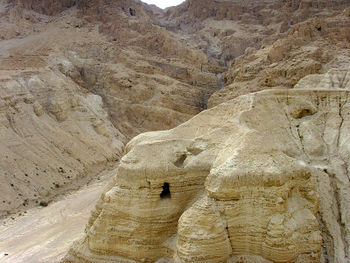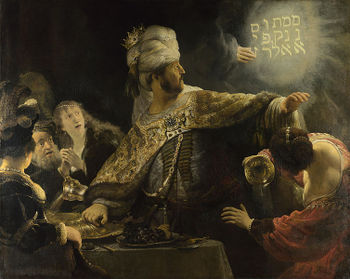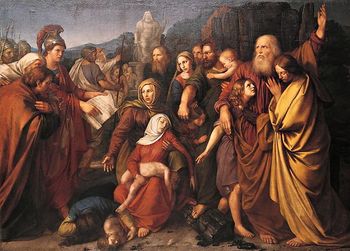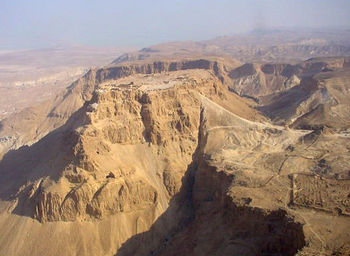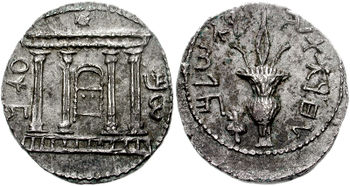History and Religion of Second Temple Judaism -- The Jewish and the Christian Messiah (2017 Boccaccini), course
<page under construction>
History and Religion of Second Temple Judaism -- TheJewish and the Christian Messiah is a course offered by Gabriele Boccaccini at the University of Michigan in Winter 2017.
Description
The seminar covers the development of Jewish and Christian Messianism in the context of the the history and religion of Second Temple Judaism, from the Monarchic period (5th-6th cent. BCE) to the emergence of Rabbinic Judaism and Christianity.
Second Temple Judaism was an age of great conflicts, in which the Jews had to face powerful neighbors and rulers: The Egyptians and the Babylonians, the Persians, the Greeks, and the Romans. It was also an age of great creativeness, in which different varieties of Judaism (including the early Christian movement) developed sophisticated and lasting theologies and restlessly struggled for supremacy or survival.
The focus is on reading of primary sources in the original text (or English translation), within a methodological approach that frees the documents from the cages of their denominational corpora and restores their original links, as representatives of competing forms of Judaism.
Grading is based on daily reading assignment, oral presentations, and a final research paper.
Syllabus
Introduction
(1) January 5, 2017 - Introduction
- The Jewish and the Christian Messiah, Today
(2) January 12, 2017 - How Israel Became Monotheist
- (a) The Legacy of Polytheism
- (b) Kings and Priests in pre-Exilic Israel
(3) January 19, 2017 - The Origins of Jewish Messianism - See Messiah in Ancient Israel
- (a) The Prophecy of Nathan to the House of David
- (b) The Messiah as the Adopted "Son of God"
(4) January 26, 2016 - Israel after the Exile
- (a) The Priest Messiah: The Rise and Fall of the House of Zadok
- (b) Enochic Judaism as and Anti-Messianic movement
(5) February 2, 2016 - The End of Times and the Messianic Age
- (a) The Animal Apocalypse (1 Enoch 85-91)
- (b) The Book of Daniel (chs. 7 & 9)
(6) February 9, 2016 - The Royal Messiah
- (a) Israel under Roman Rule: Herod the Great and His Successors
- (b) The Psalms of Solomon
(7) February 16, 2016 - The Apocalyptic Messiah
- (a) The Parables of Henoch
- (b) 2 Enoch and the Mechizedek Messiah
(8) February 23, 2016 - The 1st-Century Messiah
- (a) Messianic Claimants
- (b) John the Baptist
< March 2 - Spring Break >
(9) March 9, 2016 - Jesus, the Son of Man
- The Gospel of Mark
(10) March 16, 2016 - Paul of Tarsus
- (a) The Death of the Messiah
- (b) The Messiah as the New Adam
(11) March 23, 2016 - The Fulfillment of All Prophecies
- (a) The Gospel of Matthew and Luke
- (b) The Deutero-Pauline literature (Letter to the Hebrews & Colossians)
(12) March 30, 2016 - The Gospel of John
- (a) The Messiah as the incarnated Word of God
- (b) The "I Am" sayings of Jesus
(13) April 6, 2016 - The Jewish and the Christian Messiah: The Parting of the Ways
- (a) The Revelation of John vs. 4 Ezra and 2 Baruch.
- (b) Justin the Martyr vs. Targum Neofiti
(14) April 13, 2016
- Paper presentations.
Major sources
Research Paper
The first draft (3-5 pages) is due by March 23. The second draft (10-15 pages) by April 15, revised after the oral presentation (10-15m each on Apr 13). Final paper (12-20) pages by Apr 20.
The format of the final paper is as follows (four chapters):
3-5 pages = Detailed description of the most important things that you have learned from the assigned book + 3-5 pages = Description of the most important things that you have learned in class. + 3-5 pages = Comparison between what is stated in the book and what you have learned in class + 3-5 pages = Development of a special topic of your choice (related to the content of the class), based on at least one additional reading.
Total = 12-20 pages.
You will be presenting orally in class (April 13) the most important conclusions of your paper in class (10-15m each), before presenting the final written draft (between April 15 and 20). You have two weeks to prepare your oral presentation and one additional week to complete your written paper.
Bibliography (pick up a book of your choice to begin with)
- (++) How Jesus Became God: The Exaltation of a Jewish Preacher from Galilee (2014 Ehrman), book
- The Messiah: A Comparative Study of the Enochic Son of Man and the Pauline Kyrios (2011 Waddell), book [Peter Yousif]
- The Only True God: Early Christian Monotheism in Its Jewish Context (2009 McGrath), book [Clarence Wamack]
- King and Messiah as Son of God (2008 Collins/Collins), book
- You Are a Priest Forever: Second Temple Jewish Messianism and the Priestly Christology of the Epistle to the Hebrews (2008 Mason), book
- The One Who Is to Come (2007 Fitzmyer), book [Tyrone Edwards]
- The Messiah: Messianism in Early Judaism and Christianity (2007 Zetterholm), edited volume [Abrar Quazi]
- How on Earth Did Jesus Become a God? (2005 Hurtado), book
- (++) The Scepter and the Star (1995 Collins), book [Derek Jacob]
- (++) From Jesus to Christ: The Origins of the New Testament Images of Jesus (1988 Fredriksen), book - 2nd ed. 2000. [Jhawan Davis]
- Bandits, Prophets, & Messiahs (1985 Horsley), book [Thomas Haulichek]
Textbooks and Essential Bibliography
Textbooks:
G. Boccaccini, Roots of Rabbinic Judaism: An Intellectual History, from Ezekiel to Daniel (Eerdmans: Gran Rapids, 2002)
Additional Bibliography:
- J.J. Collins, The Apocalyptic Imagination: An Introduction to Jewish Apocalyptic Literature (Grand Rapids: Eerdmans, 1998)
Grading System
The Grade will be determined by two factors:
- (a) Individual paper (50%)
- (b) Participation in class (50%) - including the 15m final oral presentation of the paper
The paper will be on a topic chosen by the student and approved by the instructor. The first draft (3-5 pages) is due by March 15. The second draft (10-15 pages) by April 15.
